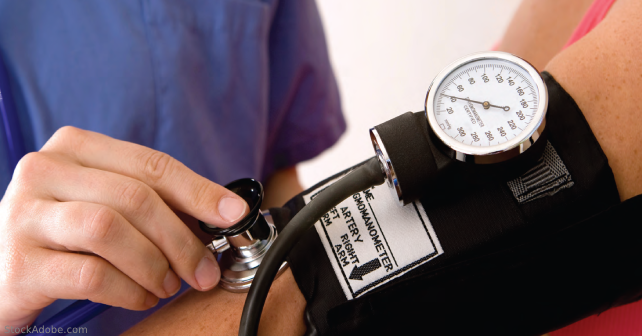
Treating elevated blood pressure (BP) in patients being discharged from the emergency department (ED) is often a challenge for emergency physicians (EPs). Often, EPs refrain from prescribing anti-hypertensive therapy on discharge due to a perception that many of these patients may not require ED care, and the likelihood of adverse outcomes, such as stroke or myocardial infarction, is minimal. Furthermore, EPs can find this patient population challenging or frustrating to manage, as they have been made anxious or concerned about an imminent stroke or myocardial infarction and frequently frightened by an outside health care worker who has little understanding of the real risk of acute, severe outcomes. Yet with nearly half of patients treated and discharged from the ED registering an elevated BP reading during their visit, hypertension is a problem that EPs cannot ignore.1
Explore This Issue
ACEP Now: Vol 43 – No 05 – May 2024Hypertension is a well-established long-term risk factor for adverse cardiovascular outcomes and premature mortality, which is why managing hypertension is routine in the primary care setting. However, the optimal outpatient management on ED discharge is unclear and varies widely among EPs, with between 6 percent and 43 percent of patients receiving a prescription on discharge.1,2,3,4 This practice variation is partly a result of a lack of evidence of benefit, as well as little concrete guidance from authoritative bodies. ACEP last updated its Clinical Policy for Managing Patients with Asymptomatic Elevated Blood Pressure in 2013, stating that “routine ED medical intervention is not required,” but that EPs may “initiate therapy for long-term control” in selected populations, such as those with poor follow-up.5 This recommendation was classified as Level C, meaning that it was based on expert consensus and had a low level of data quality. Complicating this lack of evidence and guidance on treating elevated BP, EPs may have a sense that elevated BP is a low acuity problem, best managed long-term by the primary care physician. Ultimately, EPs are often ambivalent about whether to prescribe an anti-hypertensive to the discharged hypertensive patient.
We know from the literature that prescribing antihypertensives at discharge is a safe practice, with no increased short-term risk of adverse effects.2,4 Perhaps the greatest fear of the EP, that of precipitating a stroke as a result of a rapid drop in BP after discharge, does not appear to be a risk.2 However, what remains unclear is whether there is a short-term benefit to prescribing anti-hypertensives at the time of discharge. After all, EPs typically will prescribe a week or at most a month of medication, after which hopefully the patient will follow up with their primary care physician for long-term management. If, however, a short-term benefit of treating hypertension after ED discharge could be demonstrated, then a re-evaluation of EP practice with this patient population would be worth considering.
We investigated this very question, which was published in the April issue of JACEP Open (“Antihypertensive prescription is associated with improved 30-day outcomes for discharged hypertensive emergency department patients”). In a retrospective study of 93,512 hypertensive patients discharged from eight EDs, we asked whether prescription anti-hypertensive therapy was associated with a decreased risk of an adverse event (aortic dissection, acute heart failure, myocardial infarction, stroke, and hypertensive encephalopathy) within 30 days of discharge. Consistent with prior studies, we observed a low risk of events, with an adverse outcome occurring in just 0.7 percent of patients within 30 days mortality was 0.1 percent. This should reassure EPs that discharging hypertensive patients is safe.
Despite the overall low rate of adverse outcomes, we found that ED prescription of anti-hypertensive therapy can further lower the risk of an adverse outcome. Prescribing antihypertensive therapy was associated with lower odds of severe adverse outcomes within 30 days (0.2 percent) compared to the group not receiving a prescription (0.7 percent), equating to a number needed to treat of 183 to prevent one adverse outcome. Most of this observed benefit was due to a decrease in heart failure events.
Additionally, we observed a lower rate of ED revisits in the treatment group (15.5 percent) compared to the group that was not treated (10 percent), with a number needed to treat of 18 to prevent one 30-day revisit to the ED. Our results indicate that while the current practice of deferring care to primary care physicians is safe, there may be an opportunity to improve outcomes for discharged hypertensive patient.
Based on our observations, a lower threshold to prescribe anti-hypertensive therapy has the potential to both prevent 30-day severe adverse outcomes in this population and to decrease ED returns. Due to its retrospective study design, these findings require confirmation with prospective trials, and further study is also needed to investigate which specific anti-hypertensives are optimal. Given the enormous number of ED patients found to have elevated BP, a more aggressive approach to the treatment of incidentally noted ED hypertension could have significant positive effects on a population-wide scale if these findings are confirmed.
 Dr. Todd is the associate residency program director at William Beaumont University Hospital.
Dr. Todd is the associate residency program director at William Beaumont University Hospital.
References
- McAlister FA, Youngson E, Rowe BH. Elevated blood pressures are common in the emergency department but are they important? a retrospective cohort study of 30,278 adults. Ann Emerg Med. 2021 Apr;77(4):425-432.
- Brody A, Rahman T, Reed B, et al. Safety and efficacy of antihypertensive prescription at emergency department discharge. Acad Emerg Med. 2015 May;22(5):632-5.
- Cho DD, Austin PC, Atzema CL. Management of discharged emergency department patients with a primary diagnosis of hypertension: a multicentre study. CJEM. 2015;17(5):523-531.
- Levy PD, Mahn JJ, Miller J, et al. Blood pressure treatment and outcomes in hypertensive patients without acute target organ damage: a retrospective cohort. Am J Emerg Med. 2015;33(9):1219-1224.
- Wolf SJ, Lo B, Shih RD, et al; American College of Emergency Physicians Clinical Policies Committee. Clinical policy: critical issues in the evaluation and management of adult patients in the emergency department with asymptomatic elevated blood pressure. Ann Emerg Med. 2013;62(1):59-68.
Pages: 1 2 3 | Multi-Page


No Responses to “Hypertensive Patient Discharge and Management”